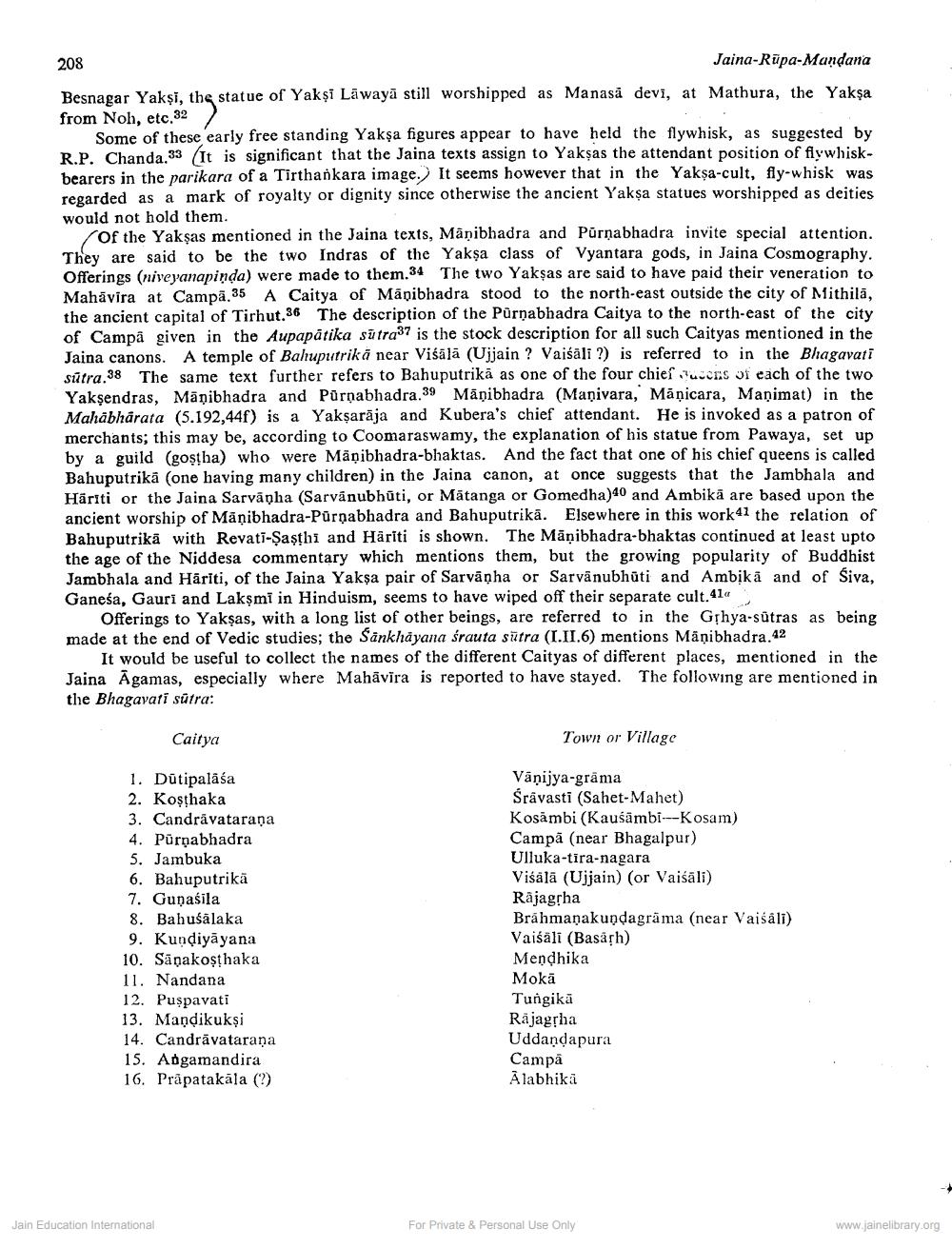________________
208
Jaina-Rupa-Mandana Besnagar Yakşi, the statue of Yaksi Lāwayā still worshipped as Manasă devi, at Mathura, the Yakşa from Noh, etc.32
Some of these early free standing Yaksa figures appear to have held the flywhisk, as suggested by R.P. Chanda.33 (It is significant that the Jaina texts assign to Yakşas the attendant position of flywhiskbearers in the parikara of a Tirthankara image. It seems however that in the Yakşa-cult, fly-whisk was regarded as a mark of royalty or dignity since otherwise the ancient Yaksa statues worshipped as deities would not hold them.
of the Yaksas mentioned in the Jaina texts, Manibhadra and Purnabhadra invite special attention. They are said to be the two Indras of the Yaksa class of Vyantara gods, in Jaina Cosmography. Offerings (niveyanapinda) were made to them.34 The two Yaksas are said to have paid their veneration to Mahavira at Campā.35 A Caitya of Manibhadra stood to the north-east outside the city of Mithila, the ancient capital of Tirhut.36 The description of the Purnabhadra Caitya to the north-east of the city of Campã given in the Aupapătika sūtra37 is the stock description for all such Caityas mentioned in the Jaina canons. A temple of Baluputrikä near Viśālā (Ujjain ? Vaiśäli ?) is referred to in the Bhagavati sūtra.38 The same text further refers to Bahuputrikā as one of the four chief. cts of each of the two Yaksendras. Mānibhadra and Purnabhadra.39 Māņibhadra (Manivara, Mānicara, Manimat) in the Mahabharata (5.192,44f) is a Yakşarāja and Kubera's chief attendant. He is invoked as a patron of merchants, this may be, according to Coomaraswamy, the explanation of his statue from Pawaya, set up by a guild (goştha) who were Mäņibhadra-bhaktas. And the fact that one of his chief queens is called Bahuputrikā (one having many children) in the Jaina canon, at once suggests that the Jambhala and Häriti or the Jaina Sarvanha (Sarvanubhūti, or Mātanga or Gomedha)40 and Ambika are based upon the ancient worship of Manibhadra-Purnabhadra and Bahuputrikā. Elsewhere in this work 41 the relation of Bahuputrikā with Revati-Şaşthi and Häriti is shown. The Māņibhadra-bhaktas continued at least upto the age of the Niddesa commentary which mentions them, but the growing popularity of Buddhist Jambhala and Hariti, of the Jaina Yaksa pair of Sarvānha or Sarvänubhüti and Ambika and of Siva. Ganesa, Gauri and Lakşmi in Hinduism, seems to have wiped off their separate cult.414
Offerings to Yakşas, with a long list of other beings, are referred to in the GȚhya-sútras as being made at the end of Vedic studies; the Sankhayana śrauta sürra (I.II.6) mentions Mänibhadra. 42
It would be useful to collect the names of the different Caityas of different places, mentioned in the Jaina Āgamas, especially where Mahāvira is reported to have stayed. The following are mentioned in the Bhagavati sutra:
Caitya
Town or Village
1. Dūtipalāśa 2. Kosthaka 3. Candravatarana 4. Purnabhadra 5. Jambuka 6. Bahuputrikā 7. Gunasila 8. Bahuśālaka 9. Kundiyāyana 10. Sāņakoşthaka 11. Nandana 12. Puspavati 13. Mandikuksi 14. Candrāvatarana 15. Adgamandira 16. Prapatakala (?)
Vāņijya-grāma Śrāvasti (Sahet-Mahet) Kosambi (Kaušāmbi--Kosam) Campā (near Bhagalpur) Ulluka-tira-nagara Viśālā (Ujjain) (or Vaiśāli) Rajagrha Brahmanakundagrāma (near Vaisali) Vaiśäli (Basah) Mendhika Mokā Tungikā Räjagsha Uddandapura Campa Alabhikā
Jain Education International
For Private & Personal Use Only
www.jainelibrary.org




